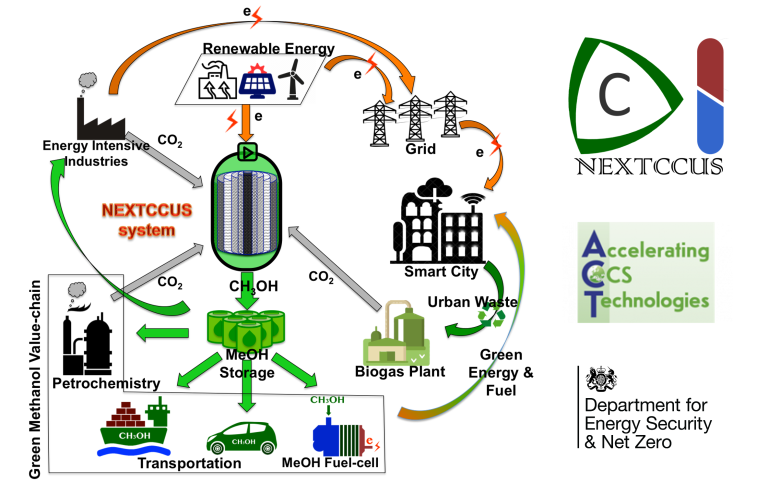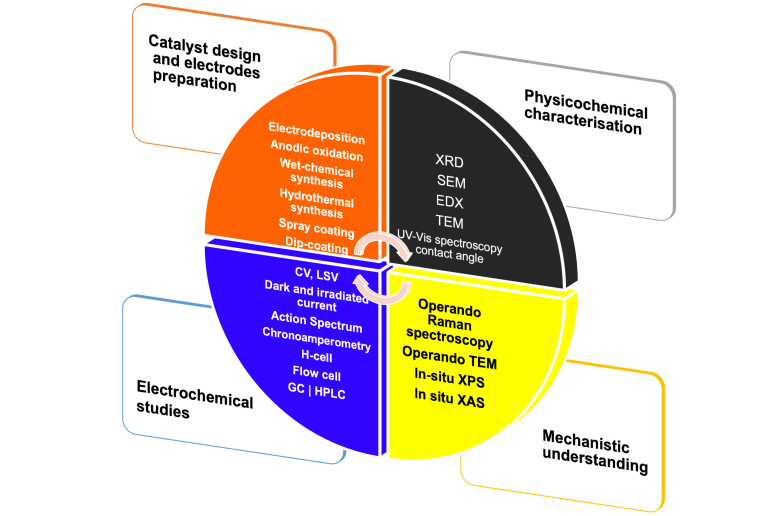Embracing clean, renewable fuels not only fights climate change by cutting emissions but also safeguards our finite resources. Join our quest for sustainable green energy solutions.
Mimicking nature, artificial photosynthesis transforms abundant molecules like CO2 and H2O into valuable chemicals using solar energy. The two major approaches include photoelectrochemical conversion (PEC) and photovoltaic-powered electrocatalysis (PV-EC). Investigating water reduction to hydrogen and CO2 electroreduction to chemicals, PEC is favored for its potential simplicity and cost-effectiveness, while PV-EC offers modular flexibility. CO2 for PEC and PV-EC can be captured from industrial emissions or directly from the air, mitigating atmospheric CO2 and providing new chemical feedstocks. The challenging yet rewarding conversion of CO2 to fuels and chemicals can be achieved at ambient temperature and pressure.
Our focus in the realm of green fuels production involves various aspects of these energy systems. In our ongoing NEXTCCUS project, we are developing electrodes and reactors for direct electrochemical CO2 conversion to methanol, ensuring high energy efficiency, over 90% faradaic efficiency, and durability. Methanol, when produced in a circular manner at ambient conditions, stands as a clean, sustainable, and readily transportable energy source. Anode development for electrochemical CO2 reduction is crucial to address CO2 crossover challenges and potential CO2 impurity in the produced O2, presenting additional engineering challenges. Leveraging our expertise in photovoltaics and electrocatalysis, we are also pioneering self-powered PV-EC devices.

Additionally, our team is at the forefront of developing novel photoelectrochemical devices for green hydrogen production. We are actively engaged in creating heterostructures for band-gap-tailored materials to achieve high solar-to-hydrogen conversion in PEC systems. In our subgroup, focus extends to perovskite-based photoelectrochemical water splitting, capitalizing on the bandgap tunability of perovskite to significantly boost solar-to-fuel performance. Join us in advancing these innovative solutions at the intersection of materials science, electrochemistry, and sustainable energy.

- Representative publications
[1] Marija Knezevic, Thi-Hieu Hoang, Nusrat Rashid, Mojtaba Abdi-Jalebi, Christophe Colbeau-Justin and Mohamed Nawfal Ghazzal, “Recent development in metal halide perovskites synthesis to improve their charge-carrier mobility and photocatalytic efficiency”, Science China Materials, volume 66, pages 2545–2572 (2023).
[2] Mojtaba Abdi-Jalebi, Nusrat Rashid, Preetam Sharma Kumar, Shurui Yang, "Next Generation Electrochemical System for Sustainable Direct CO2 Capture and Utilization/Storage as Clean Solar Fuel", https://www.nextccus.eu/.
 Close
Close

